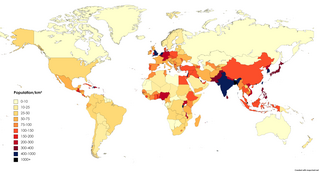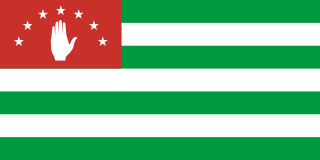European countries and territories by population density


- Figures are for the European portion of the given countries listed, unless given in italics. Total density and other details may be found in the associated note.
| Country or dependency | Europe density /km2 | Europe population | Europe area km2 | ||
|---|---|---|---|---|---|
| 1 | 18,000 | 36,298 | 2.0 | [lower-alpha 1] | |
| 4,800 | 32,688 | 6.8 | [lower-alpha 2] | ||
| 2 | 1,700 | 535,065 | 315 | ||
| 3 | 1,600 | 764 | 0.49 | [lower-alpha 3] | |
| 964 | 111,803 | 116 | |||
| 870 | 67,642 | 78 | [lower-alpha 4] | ||
| 4 | 550 | 33,642 | 61 | ||
| 5 T | 515 | 12,231,038 | 23,757 | [lower-alpha 5] | |
| 6 T | 424 | 17,618,299 | 41,543 | [lower-alpha 6] | |
| 7 | 383 | 11,686,140 | 30,528 | ||
| 8 | 277 | 67,736,802 | 244,376 | [lower-alpha 7] | |
| 9 | 253 | 654,768 | 2,586 | ||
| 10 | 247 | 39,585 | 160 | ||
| 11 | 233 | 83,294,633 | 357,581 | ||
| 12 | 213 | 8,796,669 | 41,291 | ||
| 13 T | 195 | 58,769,380 | 301,958 | [lower-alpha 8] | |
| 14 | 171 | 80,088 | 468 | ||
| 153 | 1,663,595 | 10,910 | [lower-alpha 9] | ||
| 148 | 84,710 | 572 | |||
| 15 T | 138 | 5,910,913 | 42,947 | [lower-alpha 10] | |
| 16 | 133 | 10,495,295 | 78,871 | ||
| 17 | 131 | 41,026,068 | 312,679 | ||
| 18 T | 121 | 65,823,112 | 543,941 | [lower-alpha 11] | |
| 19 | 118 | 5,795,199 | 49,035 | ||
| 20 T | 110 | 10,092,297 | 91,421 | [lower-alpha 12] | |
| 21 | 109 | 10,156,239 | 93,025 | ||
| 22 | 107 | 8,958,961 | 83,878 | ||
| 23 | 105 | 2,119,675 | 20,273 | ||
| 24 | 102 | 3,435,931 | 33,847 | ||
| 25 | 99 | 2,832,439 | 28,748 | ||
| 26 | 92 | 7,149,077 | 77,589 | [lower-alpha 13] | |
| 27 T | 90 | 45,042,385 | 498,485 | [lower-alpha 14] | |
| 88 | 364,986 | 4,163 | [lower-alpha 15] | ||
| 28 | 83 | 19,892,812 | 238,298 | ||
| 29 | 81 | 2,085,679 | 25,713 | ||
| 30 | 78 | 10,341,277 | 131,957 | ||
| 31 T | 78 | 543,800 | 6,960 | [lower-alpha 16] | |
| 32 | 72 | 5,056,935 | 69,825 | ||
| Europe | 72 | 724,404,000 | 10,011,000 | ||
| 33 | 72 | 43,649,785 | 603,549 | [lower-alpha 17] | |
| 34 | 71 | 4,008,617 | 56,594 | ||
| 35 | 63 | 3,210,848 | 51,209 | ||
| 36 | 61 | 6,687,717 | 110,372 | ||
| 37 | 46 | 9,498,238 | 207,600 | ||
| 38 | 45 | 626,485 | 13,888 | ||
| 39 | 42 | 2,718,352 | 65,286 | ||
| 38 | 53,270 | 1,393 | [lower-alpha 18] | ||
| 40 | 29 | 1,322,766 | 45,399 | ||
| 41 | 28 | 1,830,212 | 64,594 | ||
| 42 T | 27 | 107,630,419 | 3,952,550 | [lower-alpha 19] | |
| 43 | 24 | 10,612,086 | 438,574 | ||
| 19 | 30,129 | 1,583 | [lower-alpha 20] | ||
| 44 | 17 | 5,474,360 | 323,772 | [lower-alpha 21] | |
| 45 | 16 | 5,545,475 | 336,884 | [lower-alpha 22] | |
| 46 T | 5.7 | 840,000 | 148,000 | [lower-alpha 23] | |
| 47 | 3.6 | 375,319 | 103,000 | ||
| 0.04 | 2,530 | 62,045 | [lower-alpha 24] | ||
| C | (28) | (244,236) | (8,665) | [lower-alpha 25] | |
| 48 C | (53) | (3,728,282) | (69,700) | [lower-alpha 26] | |
| C | (14) | (56,520) | (3,900) | [lower-alpha 27] | |
| C | (72) | (18,195) | (254) | [lower-alpha 28] | |
| 49 C | (93) | (2,777,971) | (29,743) | [lower-alpha 29] | |
| 49 C | (99) | (918,100) | (9,251) | [lower-alpha 30] | |
| C | (0.03) | (56,643) | (2,166,086) | [lower-alpha 31] | |
| C | (114) | (382,836) | (3,355) | [lower-alpha 32] |










